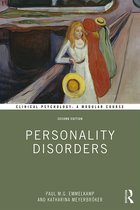Master Psychology
________________________________________________________________
, Theme 3. Me, Myself and I
Sources
DSM-5 (2013) – Dissociative Disorders
Comer (2013) – Chapter 7. Dissociative Disorders (p. 202-217)
Boysen et al. (2013)
DSM-5 Dissociative Disorders
- Dissociative disorders are characterized by a disruption of and/or discontinuity in the
normal integration of consciousness, memory, identity, emotion, perception, body
representation, motor control, and behavior, disrupting almost every area of functioning.
- Dissociative symptoms are experienced as:
- Unbidden intrusions into awareness and behavior, with losses of continuity in
subjective experience (with positive symptoms such as fragmentation of identity,
depersonalization, and derealization).
- Inability to access information or to control mental functions that normally are
readily amenable to access or control (the negative symptoms such as amnesia).
- Dissociative disorders are mostly found in the aftermath of trauma, and the proximity of
trauma is associated with desire to hide the symptoms.
- Not the same as trauma- and stress related disorders, but close to.
- Both acute stress disorder and PTSD contain dissociative symptoms (e.g., amnesia,
flashbacks, numbing, and depersonalization/derealization.
__________________________________________________________________________________
Dissociative Identity Disorder
Associated features supporting diagnosis
- The overtness or covertness of personality states is dependent on psychological motivation,
current levels of stress, culture, internal conflicts and dynamics, and emotional resilience.
, - In most non-possession-form dissociative identity disorder, the discontinuity of identity is
not overtly displayed for a long period of time.
- Sense of self and sense of agency are strongly affected, feeling emotions that are not
his/hers and one cannot control, these emotions are reported as ego-dystonic and puzzling.
- Attitudes, outlooks, and personal preferences may suddenly shift and shift back again, and
the body mostly ‘feels’ different or from someone else.
- Non-epileptic seizures and other conversion symptoms are prominent, especially in non-
Western settings.
- Dissociative amnesia manifests in 3 ways:
- Gaps in remote memory of personal life events.
- Lapses in dependable memory.
- Discovery of evidence of their everyday actions and tasks that they do not recollect
doing.
- Dissociative fugues (= dissociated travel) are common.
- Individuals with dissociative identity disorder vary in their awareness and attitudes toward
their amnesias, it is common that they minimize the amnestic symptoms.
- Possession-form identities typically manifest as behaviors that appear as if a spirit,
supernatural being, or outside person has taken control.
- However, to meet criteria for dissociative identity disorder, the identities that arise
during possession-form dissociative identity disorder present recurrently, are
unwanted and involuntary, cause distress or impairment, and are not a normal part
of a broadly accepted cultural or religious practice.
- They often have comorbid depression, anxiety, substance abuse, self-injury, non-epileptic
seizures, or another common symptom.
- They often have dissociative flashbacks of an event in the past as if it was happening in the
present.
- They often report multiple types of interpersonal maltreatment during childhood and
adulthood.
- Nonmaltreatment forms of overwhelming early life events, such as multiple long, painful
medical procedures, are also often reported.
- Self-mutilation and suicidal behavior often occur, high hypnotizability.
- Sometimes transient psychotic phenomena.
- Brain regions implicated in pathophysiology of dissociative identity disorder are OFC,
hippocampus, parahippocampal gyrus, and amygdala.
Prevalence
- 12-Month prevalence among adults in a small US community study was 1.5%, prevalence
across genders in that study was 1.6% for males and 1.4% for females.
Development and course
- Associated with overwhelming experiences, traumatic events, and/or abuse occurring in
childhood.
- Full disorder may manifest at almost any age (from earliest childhood to late life), although
children do not present with identity changes, but more overlap and interference among
mental states.


